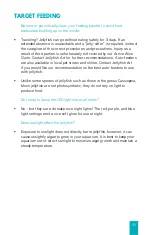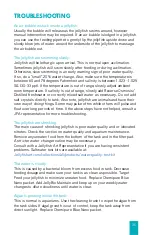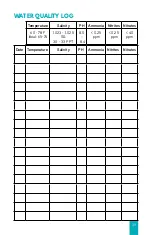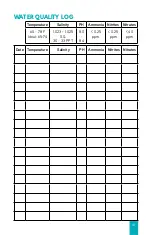
36
A jellyfish is getting stuck to the tank wall:
This means the jellyfish has taken on shape of a suction cup and is often
caused by excess algae on acrylic. Gently use the feeding pipette to pulse
water at the jellyfish to dislodge from the wall so it starts swimming again.
The jellyfish will revert back to its natural shape shortly. Use an aquarium
brush to wipe down acrylic. Adjust the Airflow Control Valve flow - these
are the optional use yellow valves included with your kit.
A jellyfish is stuck to the back slits:
Gently use the feeding pipette to dislodge the jellyfish from the back slits.
This can mainly occur due to poor water quality and jellyfish becoming
lethargic as a result. Check the Water Quality section. Make sure the water
level is correct.
Ensure that both of your air pump outputs are set to the minimum level.
Ensure that both of the Rigid Airline Tubing (the hard, “L” shaped plastic
piece), are in the correct chambers of the filtration area.
Make sure that your black filter sponge pad is fully submerged in back
chamber and free of air bubbles. Sometimes air that is caught in the sponge
pad will obstruct the proper flow of the aquarium. Your feeding pipette or
hands can be used to prod the sponge pad and work any bubbles out.
A jellyfish is sinking or floating:
If you recently added your jellyfish to the aquarium, give them at least 24
hours to become neutrally buoyant. This happens due to a difference in
salinity. Jellyfish tend to gravitate towards li ght sources. Sinking to the
bottom could also be an airflow concern. Adjust the airflow by using the
white airflow control valve on the back of the aquarium. This may be a
result of not enough airflow. (Keep in mind, jellyfish are in a 4 dimensional
space. There is not a correct orientation when pulsing or moving about the
aquarium). Jellyfish that always hang near the surface or sink to the bottom
is a concern, and should be addressed using the information above).
A jellyfish has a hole or tear in its bell:
Make sure the jellyfish gets plenty of food so it can regenerate tissue and
heal itself. Using your Artemia Hatcher at least once a week with your
daily dry feedings will ensure proper nutrition for regeneration. Doing
an additional 30-50% water change will also help it heal. Ensure that no
bubbles are introduced into the aquarium when pouring water back in -
this can be a cause of holes in jellyfish. Do not get discouraged. Given the
proper water quality and time, jellyfish are able to heal themselves and
regenerate to a remarkable extent.
“Less is More” with jellyfish.
It is pretty
amazing to see nature’s ability to correct itself without much intervention
from us. Try not to fuss too much (or unnessicarily change water) with your
jellyfish and consult a Jellyfish Art representative with any questions.

































